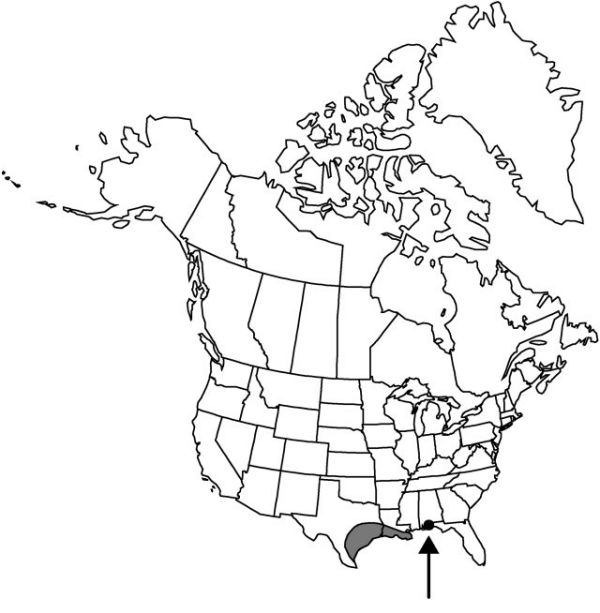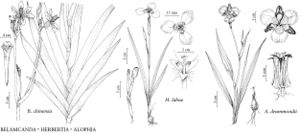Herbertia lahue
Ann. Missouri Bot. Gard. 64: 379. 1978.
Plants (6–) 8–15 (–24) cm. Bulbs (10–) 15–20 mm diam. Stems simple or 1–3 branched, branching usually from base. Leaves 4–6, mostly basal, ± reaching base of inflorescence, cauline leaves often entirely sheathing; blade ± linear, 4–6 mm wide. Rhipidia (1–) 2–5-flowered; outer spathe ca. 2/3 to ± equaling inner, inner (35–) 40–50 mm, apex becoming dry. Tepals bluish purple to violet; outer spreading, lanceolate, 23–28 × 15–18 mm, flaccid, claws white at base, speckled with violet, 6–7 mm; inner violet, darkest on claws, ca. 8–12 × 3 mm; filament column ca. 5 mm; anthers recurving soon after dehiscence, 7–10 mm; ovary oblong, 5–7 mm; style-branches 5–6 mm, forked apically for ca. 2.5 mm. Capsules ovoid–oblong-truncate, 15–25 mm. Seeds ca. 2.5 mm.
Phenology: Flowering mid Mar–early May.
Habitat: Woodlands and prairies, most common near coast
Distribution

Fla., La., Tex., South America (Argentina), South America (Brazil), South America (Chile), South America (Uruguay)
Discussion
Herbertia lahue is probably introduced in Florida.
The taxonomy of Herbertia lahue has been much confused. Plants from North America were originally treated as H. caerulea, separate from the South American members of the genus. P. Ravenna (1968) regarded differences between this and two South American species, H. lahue and H. amoena, as trivial and not sufficient to allow anything more than infraspecific separation. He considered plants from northern Argentina to be indistinguishable from those from North America and united them under subsp. caerulea. Without ennumerating their differences, Ravenna treated plants from coastal southern Brazil, Uruguay, and Argentina with slightly smaller flowers as subsp. amoena (Grisebach) Goldblatt, and those from Chile as subsp. lahue. The variation in North American populations makes it impossible to maintain even subspecies in H. lahue on the basis of available information.
Selected References
None.
